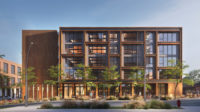On 19 nights in the summer of 2016, erectors swung steel-framed modules, each weighing more than 500 tons, from a barge moored in the East River and set them into place over New York’s FDR Drive. The elements, prefabricated at a New Jersey wharf, would form the bridgelike skeleton of what was to become a 160,000-square-foot laboratory expansion of Rockefeller University.
The FDR—the heavily traveled roadway that runs along the east side of Manhattan—was closed for each performance of the high-flying acrobatic act, conducted during the wee hours. But the scheme nevertheless required extensive logistical planning, careful coordination, and sophisticated engineering.
A number of factors made prefabrication with erection from the water a good choice for the project, explains Sherry Yin, an associate principal with Thornton Tomasetti, the project’s structural engineer. These included a difficult-to-access site with limited staging area and the possibility of minimizing construction disruptions.
Engineers and contractors had to carefully analyze the modules to maximize efficiencies while balancing the limits of what could be safely transported by water and lifted by crane over the highway. For instance, the preassembled modules—all different but each about 50 feet tall and 90 by 45 feet—arrived at the site almost completely framed, including the V portion of Y-shaped columns now visible on the new building’s eastern facade, vertical columns, braces, and beams. Sprinklers were installed at the fabrication yard, but ductwork was omitted, since the addition of sheet metal would have made the modules too heavy, says Jay Bargmann, senior vice president of Rafael Viñoly Architects. Similarly, concrete slabs were partially poured in advance to create the structural diaphragms necessary for erection, says Yin, but were completed after placement.
Stability during the delicate lifting operation was also a concern. The engineers studied the center of gravity of each module to ensure it would match that of the hoist rigging and avoid any significant eccentricity, says Yin. And, since the East River is a tidal estuary, the lifting maneuver could only be performed during slack conditions, when the water was still, narrowing the already limited time frame for the transfer.
Tim O’Connor, the university’s executive vice president, calls the approach “audacious,” and says that the 19 nights when the modules were installed were especially “nerve-racking.” But the payoffs were substantial. According to team members, the strategy shortened the project schedule by a year and shaved $20 million from the $500 million budget when compared to a conventional stick-built process.
Back to Rockefeller University River by Rafael Viñoly Architects








